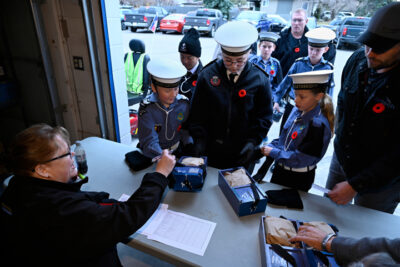A primer on poppies
By Lethbridge Herald on November 4, 2025.
 HERALD PHOTO BY JOE MANIO
Navy League Cadets receive their boxes of poppies and the location of their posts from Royal Canadian Legion Branch No. 4 former president Lynda Bly Saturday, during the kickoff of the 2025 Poppy Campaign.
HERALD PHOTO BY JOE MANIO
Navy League Cadets receive their boxes of poppies and the location of their posts from Royal Canadian Legion Branch No. 4 former president Lynda Bly Saturday, during the kickoff of the 2025 Poppy Campaign.Joe Manio
Lethbridge Herald
Local Journalism Initiative Reporter
The Royal Canadian Legion distributes approximately 18 million poppies annually prior to Remembrance Day. This is part of the larger Poppy Campaign which also includes distributing 70,000 wreaths, crosses and sprays, and raising funds for veterans, ex-service members, and their families.
For about two weeks prior to Remembrance Day, the Legion conducts the Poppy Campaign with the help of thousands of its members from coast to coast, who volunteer their time along with legions of Cadets, Scouts and other youth organizations to distribute free poppies.
Lethbridge’s General Stewart Branch #4 kicked off its local poppy campaign Saturday with young volunteers handing poppies out in person at various locations across the city.
Two important things to know about wearing poppies: first, wearing one is free. Second, should you choose to wear one, know how to wear it properly.
The poppies distributed by Legion volunteers or available from official poppy boxes anywhere in Lethbridge are free to anyone who wishes to wear one as a symbol of remembrance leading up to Remembrance Day.
A donation is not required to receive or wear a poppy anywhere in Canada. The Legion gratefully accepts donations to the Poppy Fund, but the act of wearing the poppy itself is a personal choice to honour veterans and not a financial transaction.
Any funds raised from voluntary donations are held in trust and used to support Canadian veterans and their families in need, covering costs for essentials like food, shelter, and medical expenses.
The most important aspect is to wear the poppy with respect for especially Canada’s war dead, those fallen Veterans who gave the “last full measure of devotion” while serving in Canada’s armed forces.
The proper way to wear a Remembrance Day poppy is on the left side, over the heart, during the “remembrance period” from the last Friday in October until Nov. 11.
Ensure the poppy is not obscured and is affixed respectfully, as it’s a symbol to honour those who have served and especially those who died while serving.
Legion protocol states that the poppy is a sacred symbol of remembrance and should not be defaced or altered in any way.
The only permitted “alteration” in the centre is the use of the Legion’s own reusable black center pin, which is a specific type of pin holder designed to be in keeping with the poppy’s appearance and secure it better than the standard pin.
The centre must remain black (reflecting the poppies in Flanders fields). Altering its color (such as to green or yellow) is not permitted for commercial use and is against the official design guidelines.
At the end of Remembrance Day, you can either keep the poppy respectfully or dispose of it by placing it on a war memorial or cenotaph. Keeping it is a personal choice, and you can store it or wear it year-round at other commemorative events. Placing it on a memorial is a popular tradition that shows continued respect.
Inspired by Lieutenant-Colonel John McCrae’s poem In “Flanders Fields,” the Poppy was adopted by The Royal Canadian Legion in 1921 as a sacred symbol to commemorate the service and sacrifices of fallen Veterans.
Flanders Field was a major front in World War I and the battles there, particularly the Battle of Passchendaele, became symbols of the senselessness of modern warfare. Over a million soldiers from more than 50 countries were killed, wounded, or went missing in action in this region.
The red poppies that famously bloomed in the disturbed soil became a powerful symbol of remembrance and are mentioned in the first line of the poem: “In Flanders fields the poppies blow.” And poppies are mentioned in the final stanza: “We shall not sleep, though poppies grow.”
The Royal Canadian Legion was founded in 1925 by Canadian Veterans and for Veterans, and advocates for the care and benefits for all who served Canada, regardless of when or where they served. The Legion supports those who serve Canada with a wide variety of services.
20-19


has to be a smarter way – between the sharp pins and the what becomes a notable plastic waste afterward, this is hardly a practice that accounts for sustainability and the land.
could not at least a compostable product be configured along with a compostable or reusable clip?